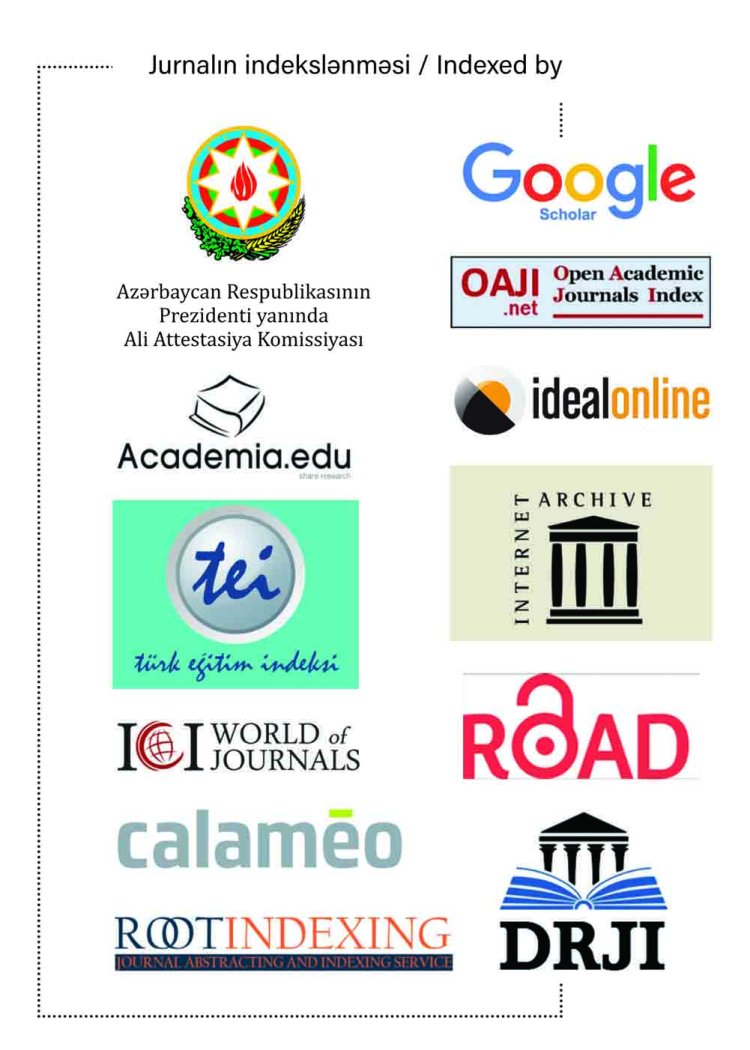PROJECT-BASED LEARNING APPROACH: EXPLORING INFLUENCE OF STUDENTS’ SERVICE-LEARNING PROJECT ON HEALTH AND WELL-BEING AWARENESS IN THE SCHOOL COMMUNITY
AFAT NABIYEVA, Coordinator/Advisor (Projects) Khazar University, Dunya IB School, Baku, Azerbaijan. E-mail: [email protected] https://orcid.org/0009-0009-3456-8669
Project-Based Learning (PBL) is an instructional approach that blends regular classroom education with real-world projects to involve students in actual learning experiences. The study's primary goal was to explore the influence of students' service-learning projects on health and well-being awareness in the school community at one of the private schools in Baku, Azerbaijan. Students' project-based learning was based on the Sustainable Development Goals (SDGs) issue of health and well-being in the school community, which allowed the authors to gather data for the study. Participants in this study included the host school's teacher, private school students, and invited guests from the public school, which included high school and university students. As part of this project, numerous sporting events and workshops were held. A volleyball game between teachers and students from the private school was the first event, and there was n=63 participants. A school community sport workshop was the following event, and it attracted n=26 participants from both public and private schools as well as university students. In order to evaluate how the PBL approach affected students' knowledge of project delivery, how it affected the school community, and how it affected participants' motivation, data were collected using an online survey and interviews with teachers, students, and observers who participate in the volleyball event. A regression analysis was conducted to evaluate the project influence of physical health education and service as action department collaboration on awareness of health and wellbeing in the school community Seminar n=26 (M = 8.88, SD =1.92) and Overall Workshop activity (M = 9.76, SD =.429) We found a statistically significant main effect of Overall Workshop activity, F (13, 165) = 29.6, p = .000. and we also found a strong correlation between average organizing school community project and students and staff motivation, r (.627) = .63, p < .000. As a result of the students' project, the PBL method demonstrated effective collaboration among the students. Through a project, the school community considerably improved, fostering an
active and engaged learning environment, enhancing information sharing, and enhancing student engagement in various elements of the school.
INTRODUCTION
Students’ understanding of health and wellness within a school community has been positively influenced through physical health and education in conjunction with service as action department. Students are taught the value of proper nutrition, exercise and personal hygiene as well as how these ideas can lead to better mental health and academic achievement through the combined efforts of these two departments. The inclusion of these subjects in the curriculum gives students knowledge about how to live a healthy lifestyle and advance a wellness culture in their neighborhoods. Additionally, by working together, students may get essential networking chances and volunteer activities that help them advance their professional and personal development. Project-based learning, a student-centered approach, encourages active inquiry of real-world challenges and problems through tasks like spending a lot of time working on a challenging question, challenge or problem. It is distinct from classroom instruction led by a teacher or rote memory based on paper, which provides known knowledge or implies a straight-forward path to comprehension. According to Dole et al., (2017) PBL has a positive influence on student performance, motivation and engagement through increasing creativity, critical thinking, cooperation and communication. Some people argue that encouraging students to think creatively and view learning as a process with a purpose rather than mindless memorization is possible through the use of project-based learning. Project-based learning has a number of benefits, such as improved conceptual understanding, a broader background knowledge, extended social and interaction skills, improved managerial skills, increased creativity and improved writing abilities. It also entails a method of instruction whereby students work together to resolve problems from the outside world. When solving problems, students must integrate their knowledge from several disciplines and put it to use. The potential for real-world influence serves as a motivator for learning. As project-based learning focuses on long-term, trans disciplinary and student-centered learning activities, students are given the opportunity to organize their own work, choose their topic based on personal interest and manage their own time in a project-based class. It differs from typical teacher-led classroom activities and promotes the creation of group or individual artefacts to illustrate what is being learnt. Moreover, it gives students the chance to investigate issues and challenges with real-world applications that increases the likelihood that knowledge and skills will be retained throughout life. Students have the chance to actively engage in a real-world application of the concepts learnt in the classroom through their service-based project that is centered on the sustainable development goal of health and wellbeing. As they collaborate to enhance the health and wellbeing of their community, it can help cultivate a sense of civic responsibility and stewardship among pupils. Students can develop crucial interpersonal skills and gain valuable leadership experience by working with local organizations and taking part in service-based initiatives like wellness initiatives, health awareness campaigns and nutrition education. These abilities will help them both inside and outside of the classroom.
Statement of problem
The importance of physical activity in promoting both a healthy lifestyle and academic success is not widely understood by students in many Azerbaijani schools. In the study conducted by Fathi et al., (2014)The following five general themes emerged as the main obstacles such as collaboration among and across sectors; development of policies and regulations; infrastructure and capability; personnel; and engagement of the community. In another study by Sodiya & Imanguliyeva, (2021) The outcome demonstrated the widespread subject swapping of physical education lesson in public schools which has an influence on the promotion of a healthy lifestyle and students’ comprehension of the value of physical activity in many Azerbaijani schools. Students will ultimately have a more severe than optimal learning experience due to a lack of physical and mental activities that are centered on the health and well-being of the school community that will lead to demotivation and ineffectiveness in both teaching and studying. The planning, implementing out and evaluation of projects used in project-based learning are equally crucial as the projects themselves. This research examines the influence of physical health education and service as action department collaboration on health and wellbeing awareness in the school community and project-based learning evaluation skills. The following five general themes emerged as the main obstacles such as Collaboration among and across sectors; development of policies and regulations; infrastructure and capability; personnel; and engagement of the community.
Purpose of Study
This study’s three purposes are served by using the Sustainable Development goals, notably those that focus on health and wellbeing, as the basis for a service-learning initiative for students in a school community. First, it allows students to put what they have learned in the classroom into practice in a real-world situation, giving them the chance to gain real-world experience and knowledge that will be helpful for their future professional or personal aspirations. Second, it promotes civic responsibility and stewardship toward their community and others, helping to create a culture of service and responsibility within the student community. Additionally, it improves the community’s and its residents’ general quality of life while advancing the larger objectives of sustainable development. In summary, assisting students develop project delivery abilities such as project implementation, project evaluation and project planning, utilizing the PBL technique’s five steps and to assess the effects of the students’ SDGs project on the entire school community.
Objectives of Study
The objectives of this study are
- To explore outcome of the students’ project implementation, project evaluation and project planning, utilizing the PBL technique’s five steps by investigating and responding to realworld situations
- To examine the effects of the students’ SDGs project on the entire school community.
- To explore influence of physical health education and service as action department collaboration on awareness of health and wellbeing in the school community
Research Questions
The direction of the investigation was guided by the following research questions below.
- What is the outcome of the students’ project implementation, project evaluation and project planning, utilizing the PBL technique’s five steps by investigating and responding to real-world situations?
- Is there any influence of the students’ SDGs project on the entire school community after volleyball Match between Teacher and Students?
- Is there any influence of physical health education and service as action department collaboration on awareness of health and wellbeing in the school community?
LITERATURE REVIEW
There is an abundance of literature on the PBL strategy and effects. Ayton & Capraro, (2021) feedback from students is a critical component of all PBL approaches. Reflective notebooks were utilized for this project to gather information regarding the PBL experiences of primary education teachers in training. Students who engage in project-based learning get the knowledge, networks, and abilities necessary to plan campaigns and projects that address societal concerns. In addition to providing hands-on training in project management, community involvement, fundraising, communication, and research-related topics, it places a strong emphasis on student collaboration and intercultural understanding (Koh et al., 2010). It promotes critical thinking, teamwork, and problem solving in the real world and is learner-cantered with an emphasis on knowledge and skill acquisition. Also crucial are preparation, execution, and evaluation. This article examined how PBL may be used to apply the SDGs to enhance the health and wellbeing of school communities, and it also provided the survey findings from a student project. The goal of the student project, which was carried out using the PBL methodology, was to use the SDGs to enhance the health and welfare of the school community. The project involved surveying the school community to determine the achievement of the project organized by applying PBL showed that the project met its goals, leading to appreciable improvements in the school community’s health and wellbeing.
Treadwell, (2018)the distinctive characteristics of PBL Project-based learning and the case for its adoption is made by giving students various projects targeted at improving physical activity during the school day. which make it especially helpful for solving complex challenges like boosting health and wellbeing in school communities, can be credited with the project’s success. PBL enables students to participate in active and collaborative learning, where they collaborate to find solutions to problems in their community. This method aids in the development of students’ critical thinking and problem-solving skills as well as social and emotional qualities including empathy, teamwork, and communication. Students were able to relate their classroom learning to actual problems and get a sense of agency and responsibility for establishing positive relationships among the members of the school community as well as contributing to the betterment of their mental, physical and spiritual well-being by using the SDGs as a framework for their project.
Theoretical Framework
Experiential learning theory is a conceptual framework that posits that learning is most effective when it is based on first-hand, hands-on experience. This theory assumes that students are more likely to engage with the material and learn through direct interaction, participation, and observation, as opposed to passive, memorization-based learning. Applied to a service-based project in a school community, experiential learning theory can be used to design activities that are both meaningful and challenging for the students, allowing them to learn from the experiences and apply the knowledge to their own lives. According to Jon Ord, (2012) with the concept of experiential learning, all activities happen in a collective setting. Knowledge is founded on experiences and is socially produced. This information needs to be arranged in the context of relevant, everyday experiences. Godfrey Smith, (2014) the concepts and tenets of project-based learning included the idea that a teacher should not be in a school to force a student to adopt a particular viewpoint or set of behaviors but rather should be a member of the community who chooses the influences that would have an influence on the student. The researcher advocated using creative or constructive endeavors as the focal point of correlation.
Conceptual Framework
The conceptual framework indicates the process of the need assessment analysis and the application for the of PBL in educating students as global citizens. After the need assessment analysis lack of physical activities in the school community and lack of student’s project implementation skills were highlighted. This brough a collaboration between physical health education and service as action department. Students were advice to conduct their service in action projects on physical activity and wellbeing from as one of the sustainable development goals. Students were trained and given feedback on PBL approach to guide their projects (Figure 2), the whole school community participated in the organized one month of physical activity events and workshop. The evaluation was conducted and the qualitative and quantitative result were presented in the finding and discussion as seen in Figure1.
Figure 1 Conceptual framework school based project
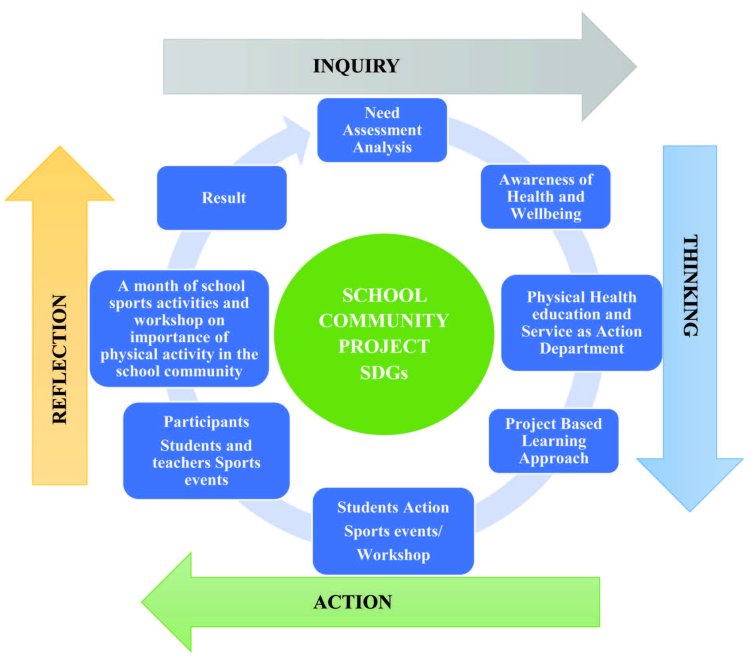
The PBL in educating students as global citizens can be organized around the following key components:
- Pedagogy: PBL is an active learning approach that is student-centered and inquiry-based. It encourages students to collaborate, communicate and problem-solve in real-world contexts, which helps them develop a deeper understanding of global issues.
- Curriculum: PBL can be used to teach a wide range of subjects, including social studies, science, mathematics and language arts. The curriculum should be designed to integrate global issues and promote interdisciplinary learning.
- Assessment: Assessment in PBL should be authentic, formative, and summative. It should focus on assessing not only students’ knowledge but also their skills and attitudes related to global citizenship.
- Learning Outcomes: The learning outcomes of PBL should focus on the development of global competencies such as critical thinking, communication, collaboration, cultural awareness and social responsibility. These competencies are essential for students to become responsible and active global citizens.
- Teacher Training: PBL requires a shift in the role of the teacher from a content provider to a facilitator of learning. Teachers need to be trained to design, implement and assess PBL activities effectively.
- Contextual Factors: The influence of PBL on global citizenship education is influenced by contextual factors such as culture, language, socio-economic status, and access to technology.
These factors need to be taken into account when designing and implementing PBL activities. In summary, PBL can be an effective pedagogical approach for educating students as global citizens. The influence of PBL on global citizenship education can be maximized by integrating global issues into the curriculum, assessing global competencies, focusing on authentic and interdisciplinary learning outcomes, training teachers in PBL and considering contextual factors.
Figure 2 The influence of project-based learning in educating students as a global citizen
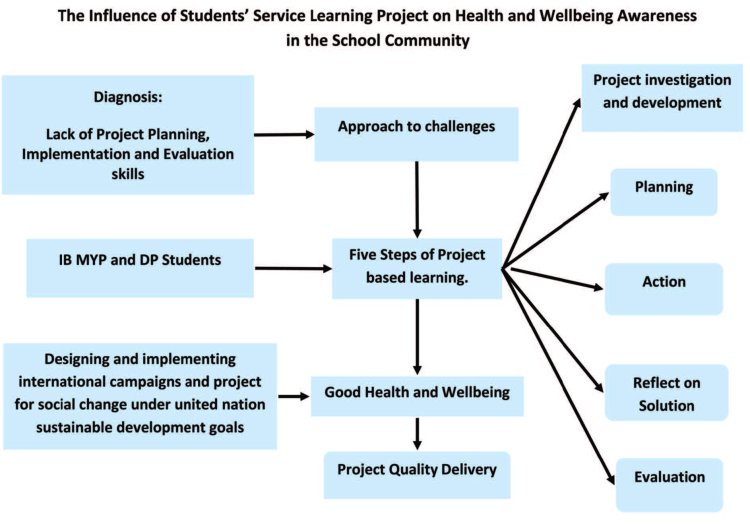
As seen in Figure 2 the research conceptual framework was designed as a template on how the teacher identified the students’ problems and applied solution using the PBL approach to help students develop the skills needed for the SDGs projects for community development.
Promoting Physical Activity and Wellbeing on School Campus
As stated in Pulimeno et al.,(2020) promoting students’ well-being can boost their academic performance by decreasing negative consequences and encouraging critical thinking. Early intervention and health promotion in the classroom can encourage students to learn about their own health and adopt healthy behaviors, but this requires teachers to have the necessary training. According to Biddle & Asare, (2011), since 2011, both the quantity and quality of research have considerably increased, with the most significant characteristics being depression, self-esteem and cognitive functioning. The conceptual approach of using PBL to assist students in raising awareness of the SDGs on Improving health and well-being for everyone was highlighted in this current research. The PBL gave students a chance to promote healthy living and physical activity on the school campus. According Baena-Morales et al., (2023) the report emphasizes the significance of physical education in fostering analytical and holistic thinking for sustainable development and offers useful teaching and SDG target-specific teaching strategies. The effectiveness of therapies for treating depression is moderate while those for lowering anxiety and enhancing body image have a variety of effect sizes. There is some evidence that greater or increased physical exercise and fitness are linked to better cognitive health and performance, as well as depression and other mental health problems. On the other hand, according to the findings of meta-analyses, physical activity in the classroom increased on-task behaviors and decreased off-task behavior, which in turn improved academic performance and cognitive abilities. (Marques et al., 2018) According to the study, increased cardiorespiratory fitness can boost children’s health and academic performance, although methodological concerns with measuring physical activity should be taken into account. Yet, neither cognitive processes nor physical activity was shown to be affected. The most crucial concept is that, when counseling overweight and obese people, setting goals and self-monitoring behavior are crucial for behaviors maintenance over time, especially, when utilizing a person-centered and autonomy-supportive counseling approach. (Watson et al., 2017) Another
notable information mentioned by Fukuzawa et al., (2017) is that students acquire valuable skills which can be used in a variety of fields, including teamwork, solving challenges and analytical thinking. In order to increase students’ interest in science instruction and physical exercise, the study recommends further research, development and assessment of adventure education and recreation programs (Mackenzie et al., 2018). Mackenzie`s study provided evidence that engaging in physical activity outside increases students’ enthusiasm to pursue science. In Graf et al., (2014) their research suggested that the environment should be considered while promoting physical activity. It went on to say that a students’ degree of physical activity or inactivity may also depend on factors related to their family lifestyle. As Graf have noted that family life style could have a significant influence, on the other hand, Rodríguez-Ventura et al.,( 2014) also explained that the challenges discovered were a lack of awareness of being overweight, its identification as an illness and its repercussions, a lack of time to oversee a healthy lifestyle and a significant societal pressure to eat processed foods.
Project-based learning (PBL) as an instructional approach
This review of the literature examines the efficacy of project-based learning (PBL) in developing young global citizens, emphasizing its ability to promote cultural awareness, creativity, and 21st-century skills, as well as to boost participation, academic performance, and information transfer. Augustine et al.,(2015)argues that PBL can help students develop the competencies necessary for active citizenship and responsible global engagement. The authors report that a “realworld” PBL approach can enable students to learn about global issues, develop intercultural competencies, and engage in community-based projects. Akharraz,(2021) investigated the influence of PBL on students’ cultural awareness and found that PBL can enhance students’ understanding of different cultures and their ability to communicate with people from diverse backgrounds. The study suggests that PBL can be an effective instructional strategy for promoting multiculturalism and global citizenship education. Creghan & Adair-Creghan, (2015) examined the influence of PBL on the attendance of an economically disadvantaged student population and found that PBL can significantly increase student attendance. Moallem & Igoe, (2018) PBL places learning in the context of a problem, as the name suggests. Instead of an instructional session or research project meant to instill disciplinary action, the PBL learning cycle, also known as the PBL tutorial process, often begins with the presenting of a problem. Sharma et al., (2023) investigated the influence of PBL on engineering education and found that PBL can enhance students’ problemsolving skills, creativity and ability to apply theoretical concepts to real-world situations. The study suggests that PBL can be an effective instructional strategy for preparing students for the 21st century workforce. Granado-Alcón et al., (2020) explored the influence of PBL on competencies and knowledge transfer in higher education and found that PBL can enhance students’ ability to transfer knowledge to new situations and develop competencies such as critical thinking and problem solving. Fukuzawa et al., (2017) investigated students’ motivation in response to PBL to promote student engagement, enhance critical thinking skills and improve student-learning outcomes.
Project Delivery Problem Faced by Students
According to (Barlow et al., 2016). Project-based learning requires careful project preparation. It entails deciding on the project’s scope, establishing the learning goals and objectives, outlining the activities that will be carried out and determining the resources required to finish the project. Unfortunately, many instructors lack the abilities needed to effectively design projects. One frequent issue is that teachers frequently neglect to match project goals with the overall curriculum. Projects may become disjointed from the rest of the curriculum as a result, which makes it challenging for students to understand the value of what they are learning. The curricular standards and the learning objectives they want to accomplish with the project must be understood by teachers. Another typical issue is that teachers may not understand how to appropriately scaffold the project. Scaffolding is the process of dividing large jobs into smaller, more achievable tasks. This method assists students in developing the abilities required to finish the project successfully. Teachers who lack scaffolding abilities may find it difficult to construct projects that are appropriate for their students’ learning levels (Magano et al., 2020). Many teachers lack the expertise needed to carry out projects properly that prevents students from participating in relevant learning activities and receiving help throughout the process. One difficulty is that teachers may not give students enough direction throughout the project implementation phase. Students may fail to understand the project’s requirements or the teacher’s expectations. To guarantee that students complete the project successfully, educators must provide clear directions and support. According Bausch & Becker, (2001) another concern is that teachers may not create a conducive classroom climate for project-based learning. An adaptable learning environment that promotes student participation and open dialogue is essential for project-based learning. Teachers may not use proper evaluation methods to evaluate student learning which is a prevalent issue (Harrigan, Gastrid, Walden U., 2014). Teachers must select assessment methods that match with the project’s learning objectives. Additionally, they have to guarantee that the evaluation procedures are fair, accurate and trustworthy. Another issue is that teachers may not provide pupils with specific and constructive criticism. Feedback is an important part of project-based learning because it helps students understand what they did well and where they may improve. Through project-based learning, teachers are improving their own learning that calls for careful preparation and implementation to provide the best possible student experiences (Mundy et al., 2012).
Literature Review Summary
The results of the literature review demonstrate the value of physical activity and how engaging in physical activity can improve students’ academic performance and mental health. The promotion of healthy habits can improve students’ critical and analytical thinking skills while also enhancing students’ well-being. Students can learn about their own health by participating in early intervention and health promotion in the classroom. Project base learning (PBL) can promote critical and comprehensive thinking for sustainable development and increase understanding of the SDGs. It further indicated that to execute successful teaching methods, teachers must receive training. Hence, PBL should be the main instrument used to address community challenges. Enhancing student learning and project completion is the aim of PBL. The results, however, also indicated that teachers’ lack of PBL experience contributed to students’ inability to finish projects. According to the report, educators should take part in professional development workshops to learn how to use PBL to improve students’ project-delivery abilities and foster their emergence as global citizens through participation in networks, connections and networking.
MATERIALS AND METHODS
This current study applied sequential mixed methods research, it is a method of conducting research that employs both qualitative and quantitative techniques sequentially. By combining the advantages of both approaches, this strategy enables us to perform a more comprehensive analysis of the students’ project implementation, project evaluation, and project planning, utilizing the PBL techniques and the influence of collaboration between service as action department and physical health education department on creating awareness of health and wellbeing in the school community and produce a richer, more detailed report. In the qualitative phase, a need analysis was conducted to understand the level student’s comprehension of physical health and wellbeing in the school community data are gathered through conducting class focus groups, and other approaches in order to get insight into students’ experiences and points of view. This is complemented by the quantitative phase, which makes use of statistical analysis to detect patterns, correlations, and other results that add further context and insights. The data for quantitative was gather through the activities conducted such as volleyball, football match, chess, dart, relay race, thug of war and aerobic dance workout.
Participants
Participants in this study came from both public and private schools in Baku, Azerbaijan. One of the private schools offered to serve as the project’s host, and all of the events were planned and carried out using the school’s sports facilities and art hall for the workshop. Participants included department heads, teachers and students of grade 7 and 8 of middle year program (MYP). The invited participants are public school students of grade 7 and 8 age range between 11-13 years old. The university undergraduate students age range between 19-21years old.
DATA COLLECTION
This project included two separate events that took place over the course of one month. Data were gathered from students and teachers that participated in the volley event. The supervisor produced a survey questionnaire with open-ended questions and a rating scale that was distributed to the school community through announcement on toddle platform and to students and teachers’ emails for the first data collection. The second data collection include conducting class focus groups, students were requested to write reflections based on the volleyball match event between the teachers and students and another survey questionnaire was created for the influence of physical health and wellbeing in the school community event for the overall project planning and delivery based on the workshop and all other activities that took place. The response was evaluated by the project coordinator and supervisor. Thematic coding was applied for the analysis of the participants’ responses to understand the student’s needs and experiences of physical health and wellbeing in the school community. The themes were used to create a survey questionnaire gather data for the project and feedback and evaluation.
Table 1 Project participants and events: Influence of physical health and wellbeing in the school community

First Event for data collection: Volleyball Match: Teachers and Students
It is creative and entertaining to use a volleyball game between teachers and students to raise awareness of physical health and well-being in the school community. Students created a message strategy to encourage teachers and students to take part in the game and emphasize the value of physical health and wellness in school environments. To increase attention they made posters, sent out messages to the students and used the school toddle platform. The volleyball match lasted 60 minutes and took place during the school lunch break. Students from all grade levels, from middle year program (MYP) 1 to 4 attended the event to witness the match.
Second Event for data collection: Influence of Physical health and wellbeing in the school community
Students from public, private and university schools all took part in the event’s activities, which included a workshop on the influence of health and wellbeing in the school community. The workshop program featured six presenters and various sports events like basketball, dart, tug of war with ropes, relay races, volleyball, handball and aerobic exercise dancing were played. Through the website created by the students of the host school about the influence of physical health and well-being in the school community, participants from various schools registered for this event. The entire event lasted six hours, from nine in the morning until two in the afternoon.
DATA ANALYSIS AND RESULT
After data collection was completed, we conduct proper analysis and interpretation of the data as seen below. The following research questions were answered below after the data analysis.
- What is the outcome of the students’ project implementation, project evaluation and project planning, utilizing the PBL technique’s five steps by investigating and responding to real-world situations?
- Is there any influence of the students’ SDGs project on the entire school community after volleyball match between teacher and students?
- Is there any influence of physical health education and service as action department collaboration on awareness of health and wellbeing in the school community?
QUALITATIVE FINDINGS
First Research Question
— What is the outcome of the students’ project implementation, project evaluation, and project planning, utilizing the PBL technique’s five steps by investigating and responding to real-world situations? (Data analysis based on first and second events)
The outcome of the project evaluation is presented in the table below, the evaluation answered the first research question, using the objective and outcome of the event and workshop.
The project’s detailed implementation of PBL: The teacher’s precise actions to guarantee the PBL approach’s success and the project’s influence on the school community are described below.
Step 1. Project investigation and Development
The goal of the service-learning project was to increase teachers’ and students’ participation in physical exercise by raising awareness of health and wellbeing in the school community. As part of their summative evaluation for the middle year curriculum in grade 8, students were required to complete a community service project. They had to work together on the project and present a proposal based on the SDGs topics in order to conduct research in the school context and propose methods for encouraging boys and girls to engage in healthy eating and physical activity.
Step 2. Teaching and Planning
The teacher gave students a clear project scope, described the processes of the PBL process and made sure they had the required materials and assistance to make the PBL method successful. To ensure that students stayed on task and advanced with the project, the teacher also offered frequent comments and direction.
Step 3. Action
Students met frequently throughout the project’s one-month duration to work on their study, discuss what they found and suggest an alternate approach. Students presented their findings, suggestions and perspectives on the problem during the project’s conclusion to members of the school community at large. The duty was divided among the students after they established a system of team leadership and numerous organizing committees. They provided dates for their events so that the venue could be reserved and the necessary supplies could be provided. The following events: basketball, football, meditation, volleyball, healthy food cooking competition, influence of physical health and wellbeing were planned and conducted over the course of one month.
Figure 3 Sample of student progress towards Middle Year Program (MYP) service learning outcomes
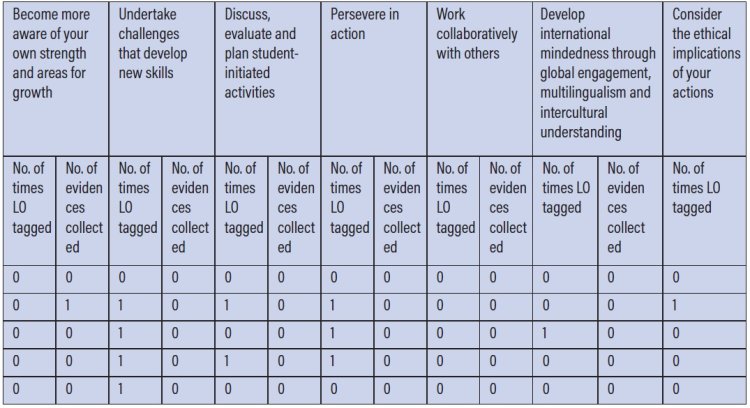
Step 4. Reflection and evaluation
The qualitative analysis was conducted using the project evaluation objectives, the project input and output, short term and long-term outcome. The analysis can be seen below in (Table 1) for the result. The second quantitative analysis result can be seen in (Table 2) systematic coding of the feedback from participants of the organized volleyball match between the teachers and students. The coding was highlighted and coded in three colors. The Red color highlighted the dissatisfaction of the participants, while the yellow color highlighted accounted for innovative suggestion from the participants and the green color highlighted and accounted for participants satisfaction, motivation, collaboration, teamwork, perfect initiative for whole school community health and well-being.
Table 2 The project evaluation’s findings on influence of physical health and wellbeing in the school community (first and second events)
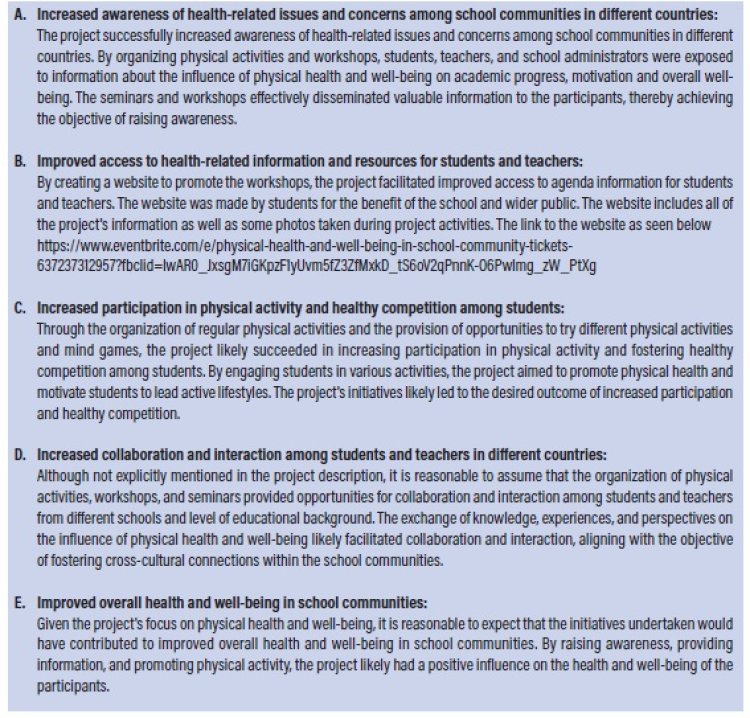
Step 5. Evaluation and Assessment
The following themes on the school’s Toddle platform were used to evaluate students. The sample is shown below; due to ethical considerations, we are unable to reveal the study’s
participants’ grades.
- Become more aware of your own strengths and areas for growth;
- Undertake challenges that develop new skills;
- Discuss, evaluate and plan student-initiated activities;
- Persevere in action;
- Work collaboratively with others;
- Develop international-mindedness through global engagement, multilingualism and intercultural understanding;
- Consider the ethical implications of your actions.
QUANTITATIVE FINDINGS
Second Research Question
— Is there any influence of the students’ SDGs project on the entire school community after volleyball Match between Teacher and Students? (Data Analysis based on First event)
Teachers and students competed in a volleyball match, the volleyball match is one of the activities in the school community’s physical health and well-being project. The data were analyzed using IBM SPSS and Excel to answer the following research questions for the study on the influence of project-based learning on educating students as global citizens.
Table 3 Descriptive analysis for participants in the volleyball event teachers vs students

Figure 4 Descriptive analysis for participants in the volleyball event teachers vs students

In table 3, project participants, we see the spread of the participants across the school staffs and students. We have teachers (n=10) who participated as an observer/spectator, program coordinators (n=2), the middle year program (MYP) teacher’s players (n=12), student’s players (n=18) and students as an observer or spectators (n=19). The head of department (HOD) as player accounted for (n=1) and lastly the head of school program coordinator as an observer and spectators accounted for (n=2). In Figure 4 you can see the cluster chat showing the spread of the participants.
In order to determine the success of using project-based learning (PBL) as a strategy for students to organize one of the SDGs on health and wellbeing, we conducted a descriptive analysis based on the responses of the Teachers and Students who participated in the volleyball match, one of the activities in the school community’s physical health and well-being project. The descriptive analysis for the participant’s responses on the question “Do you agree that organizing such events is important to improve the health of the school community? And I feel motivated to participate in similar events in the future”. The result shown below in the chart demonstrated the effectiveness of the student’s SDGs awareness project of health and wellbeing using PBL approach. Do you agree that organizing such events is important to improve the health of the school community? The total participants in the project were (n=63), the responses from the participants shows that (Strongly, n=55) and (Agree, n=8)
Table 4 Do you agree that organizing such events is important to improve the health of the school community?

Table 5 I feel motivated to participate in similar events in the future

Figure 5 Do you agree organizing such events is important to improve the health of the school community
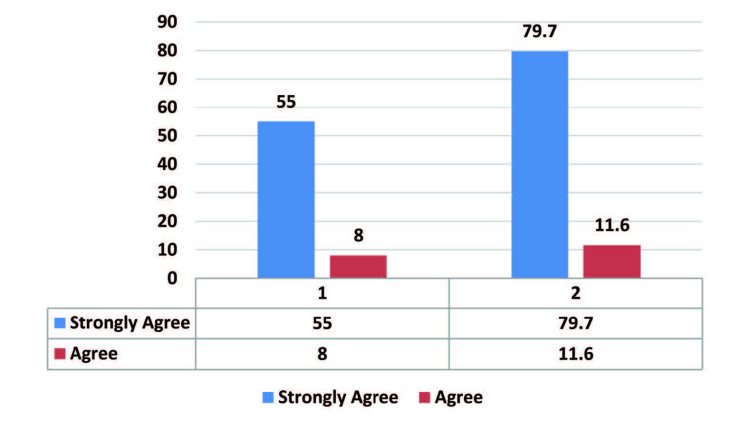
I feel motivated to participate in similar events in the future, responses indicated that out of (n=63) participants (Agree n=17) and (Strongly Agree n=46).
We found a strong correlation between organizing school community project and students, staff motivation, r (.627) = .63, p < .000. as presented in the correlations Table 6.
Table 6 Pearson Correlations between participants’ response on the importance of the volleyball event and motivation to participate in similar events in future

Figure 6. I feel motivated to participate in similar events in the future

The third research question
— Is there any influence of physical health education and service as action department collaboration on awareness of health and wellbeing in the school community? (Data analysis based on first and second events).
In order to answer the following research question, the data collected after event was input into SPSS, the table below represent statistics from a school sports event, such as the number of participants, gender, their school affiliation, their position and how many activities they participated in during the event. The descriptive statistics provided, in Gender (n=26, Female 16, Male 10), School (n=26, Private school students 16, public school students 6, University students 4). The total numbers of students that answer the survey after the program (students n=22, school staff n=4). The descriptive statistic such as the mean, variance and standard deviation were also calculated, the sample as a whole for participants (M = 13.53, SD =7.64), School (M = 1.5, SD =.760), Participants position (M = 1.15, SD =.36), while gender (M = 1.61, SD = .49) the analysis can be seen in Table 7 (Figure 7). Table 8 (Figure 8) shows the descriptive analysis for participants schools. In Table 9 (Figure 9) the descriptive analysis for participants position, while in Table 10 presents the descriptive statistics for mean and standard deviation in the second event.
Table 7 Descriptive analysis for participants’ gender in the second event

Table 8 Descriptive analysis for participant’s schools in the second event

Table 9 Descriptive analysis for participant’s position in the second event

Table 10 Descriptive statistic for mean and standard deviation in the second event

A regression analysis was conducted to evaluate the project influence of physical health education and service as action department collaboration on awareness of health and wellbeing in the school community Seminar n=26 (M = 8.88, SD =1.92) and Overall Workshop activity (M = 9.76, SD =.429) We found a statistically significant main effect of Overall Workshop activity, F (13, 165) = 29.6, p = .000.
Figure 7 Descriptive analysis for participants’ gender in the second event
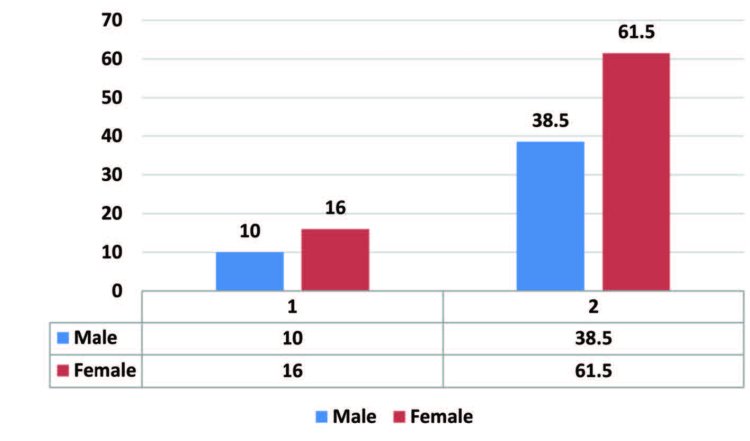
Figure 8 Descriptive analysis for participants schools in the second event

Figure 9 Descriptive analysis for participant’s position in the second event
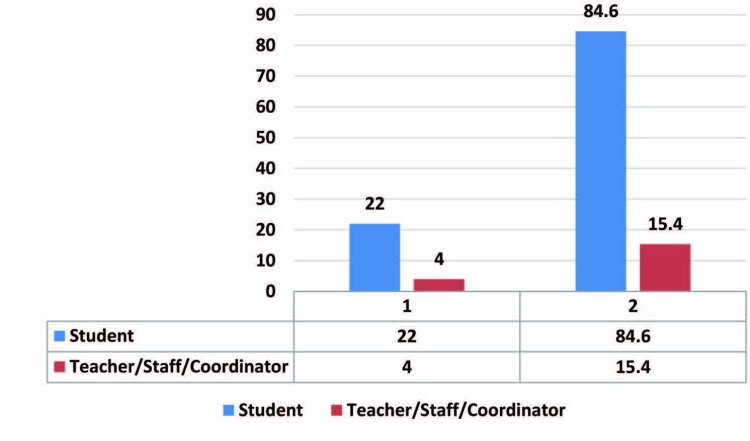
Table 11 Descriptive Statistics for workshop on

Table 12 Regression Analysis on Rate the workshop section level of Satisfaction from scale of 1-10

DISCUSSION
As stated by Kalla et al.,(2022)the main factor and result of effective environmental education is “pro-environmental behavior” which entails deliberate action to reduce unfavorable environmental influences at the individual or community level. Kalla et al., further stated that the UNESCO Education for Sustainable Development (ESD) Roadmap 2030 has identified important priority areas to promote ESD in formal curricula. The Sustainable Development Goals (SDGs) strive to attain this goal. These programs ought to promote action competence and give students the tools they need to support sustainable development. The study’s literature review lends credibility to the current project’s conclusions. The environment significantly influenced how students developed. The PBL method was used in this study approach to help students gain managerial abilities, teamwork, communication skills and an awareness of how to deliver projects for the improvement of schools and communities. Manikutty et al., (2022) also argued that children need to be given a future-focused education on important challenges, such as those included in the United Nations Sustainable Development Goals (UN SDGs) and devising viable solutions for such problems, in order to assist them navigate the uncertain world of today. As one of the guiding principles of our school community, we strive to provide students with opportunities within the international baccalaureate (IB) philosophy of inquiry, action and reflection. There are similar trends in the participants’ responses for both the Likert scale and individual feedback when comparing the quantitative and qualitative results. Students are reflecting on themselves to promote future learning and development. Students can get a “complex grasp of global concerns” and “empathy for other perspectives” through participating in PBL contexts that promote global competency, according to Soulé & Warrick, (2015), their research highlights the need for an updated educational plan that prioritizes the abilities of creativity, communication, cooperation and, critical thinking as XXI century preparation for all students in order to close social skill gaps. As stated in the findings of Birdman et al., (2022) project-based educational experiences that are both learner-driven and program-driven can lead to a successful outcome, provided that the pedagogical constraints regarding encouragement and student freedom are alleviated through teacher actions. Their study supports the findings of this current study which provided the students the opportunity active and engaging learning experiences. The project analysis result demonstrated the effectiveness of the student’s SDGs awareness project of health and wellbeing using PBL approach. According to Zwolińska et al., (2022) the practice of sustainable development education focuses on improving consciousness, proficiency, understanding, ability and mindset toward environmental protection in order to effectively satisfy the requirements of future generations. Their study also supported the result of this current study in the aspect of students’ experience, students attended classes on application of the project-based learning approach to learn how to organize, execute and evaluate projects, according, to Dunbar & Yadav, (2022) project-based learning and service learning are two student-centered pedagogies that have the potential to raise academic performance but are rarely used in school settings. We shared the students’ reflections to support the researcher’s statement considering the students’ project-related experiences.
Reflection: (Student 1) My project is to help children improve themselves in the criteria such as communicating, to make them feel comfortable around the community. Because the children we organized this project for are not just “the kids from shelter”, they have their own individual lives that we all hope they would become successful.. However, this project is not just helpful for them; it was useful for me to improve my critical thinking skills too.
Based on the student’s reflection of their experience organizing a project using PBL, it becomes evident that utilizing the PBL method aids students in improving their social skills (i.e., communication with the shelter director), research skills (i.e., identifying community needs), selfmanagement skills (i.e., organization, reflection, and emotional management) and creative and critical thinking skills, Wijayati et al.,( 2019). The findings reveal that each indication of fluency and elaboration have increased significantly, indicating that pupils’ thinking is generally in the creative category.
(Student 2) I wasn’t very punctual and organized at first due to the fact that there wasn’t much responsibility on my shoulders. The project helped me to be more focused, punctual and active. We had deadlines which we couldn’t cross because we had plans to make, we had to finish them in time and not give up the project.
Regarding the student’s reflection we can see the influence of the (PBL) approach as it enables the student to actively interact with issues and hurdles found in the real world. She was able to identify her weaknesses however, through the project the student acquired information, skills and expertise through PBL that she used to address issues in her own situation and surrounding areas. PBL is significant because it enables students to get more fundamental knowledge as well as improve critical thinking, cooperation, communication, and other crucial abilities, this is supported by the study of (Ibrahim & Rashid, 2022) . Students can learn important skills like empathy, management, organization, evaluation and compassion through service project experiences. Students can boost their self-esteem and develop a stronger sense of personal responsibility by positively affecting others. Better ATL abilities and stronger leadership traits may result from this. School community projects can foster collaboration and communication between students and instructors that will improve academic performance. Students can learn how to solve problems and obtain a greater understanding of the subject matter by collaborating on projects. Teachers can help students attain their full potential by offering advice and feedback based on their experience. Langstraat & Bowdon, (2011) the community initiatives also give students a chance to hone the collaboration, leadership, and communication skills that will be necessary for their success in the future. In conclusion, school community projects give students and instructors a great chance to collaborate and build skills that will help them succeed academically. School community projects can provide an opportunity for students and teachers to work together and develop skills that are important for academic success. Some specific examples of those skills include problem-solving, communication, collaboration and leadership, all of which are invaluable for learning and understanding (Brundiers et al., 2010). Community service projects can give students a chance to practice critical thinking and reflection as they evaluate the project and determine what went well and what needs improvement. These are just a few instances of the useful abilities that participating in school community projects can help students develop. Additionally, we discovered a significant connection between motivating teachers and students when planning school community projects.
CONCLUSION
It has been demonstrated that the project-based learning method and services as an action school community initiative have a beneficial effect on student motivation and academic achievement. PBL-based project management helps students improve their ATL-social and interpersonal skills. As a result, when the initiatives are being planned, they communicate to gather data and solicit feedback for the projects’ evaluation. The students engaged in this activity interacted with their colleagues and their rivals to come up with solutions during the game. A promising strategy that has the potential to significantly improve the performance of students and their well-being is Project-Based Learning which can incorporate the SDGs in educational settings. The achievement of the student-led initiative demonstrates the power of PBL in empowering young people to make a difference in their communities. Educators may think about using PBL as a pedagogical strategy in order to address complicated issues like the one raised in this article and to give students opportunity to apply what they have learned in a real-world situation. This study suggested that PBL and service as action in the school community are useful technique for fostering interdisciplinary research and cultivating attitudes supportive of group inquiry and reflective practice. The study’s overall contribution is to demonstrate the approach’s justification and the use of problem-based learning to provide the best possible learning environment. Teachers and administrators can improve PBL projects by creating specialized projects that encourage teamwork, critical thinking and problem-solving abilities, boosting students’ success in today’s challenging environment.
References
1 Akharraz, M. (2021). The Impact of Project-Based Learning on Students’ Cultural Awareness. International Journal of Language and Literary Studies, 3(2), 54–80. https://doi.org/10.36892/ijlls.v3i2.601
2 Augustine, T., Harshman, J., & Merryfield, M. (2015). A “Real world” approach to project-based learning in global citizenship education. In Research in Global Citizenship Education (pp. 59–82).
3 Ayton, K., & Capraro, K. (2021). Students Lead the Charge! Using Project-Based Learning with Pre-service Teachers to Redesign a Curriculum Resource Center. Education Libraries, 44, 1. https://doi.org/10.26443/el.v44i1.367
4 Baena-Morales, S., Merma-Molina, G., & Ferriz-Valero, A. (2023). Integrating education for sustainable development in physical education: fostering critical and systemic thinking. International Journal of Sustainability in Higher Education, ahead-of-p (ahead-of-print). https://doi.org/10.1108/ijshe-10-2022-0343
5 Barlow, A., Barlow, C. G., Boddam-Whetham, L., & Robinson, B. (2016). A rapid assessment of the current status of project management skills in the conservation sector. Journal for Nature Conservation, 34, 126–132. https://doi.org/10.1016/j.jnc.2016.10.003
6 Bausch, A., & Becker, K. (2001). A Study of Students’ Lack of Study and Organizational Skills with Middle School and High School Students. https://eric.ed.gov/?id=ED455461
7 Biddle, S. J. H., & Asare, M. (2011). Physical activity and mental health in children and adolescents: A review of reviews. In British Journal of Sports Medicine (Vol. 45, Issue 11, pp. 886–895). https://doi.org/10.1136/bjsports-2011-090185
8 Birdman, J., Wiek, A., & Lang, D. J. (2022). Developing key competencies in sustainability through projectbased learning in graduate sustainability programs. International Journal of Sustainability in Higher Education, 23(5), 1139–1157. https://doi.org/10.1108/IJSHE-12-2020-0506
9 Brundiers, K., Wiek, A., & Redman, C. L. (2010). Real-world learning opportunities in sustainability: from classroom into the real world. International Journal of Sustainability in Higher Education, 11(4), 308–324. https://doi.org/10.1108/14676371011077540
10 Creghan, C., & Adair-Creghan, K. (2015). The positive impact of project-based learning on attendance of an economically disadvantaged student population: A multiyear study. Interdisciplinary Journal of Problem-Based Learning, 9(2). https://doi.org/10.7771/1541-5015.1496
11 Dole, S., Bloom, L., & Doss, K. K. (2017). Engaged learning: Impact of PBL and PjBL with elementary and middle grade students. Interdisciplinary Journal of Problem-Based Learning, 11(2), 11. https://doi.org/10.7771/1541-5015.1685
12 Dunbar, K., & Yadav, A. (2022). Shifting to student-centered learning: Influences of teaching a summer service learning program. Teaching and Teacher Education, 110. https://doi.org/10.1016/j.tate.2021.103578
13 Fathi, B., Allahverdipour, H., Shaghaghi, A., Kousha, A., & Jannati, A. (2014). Challenges in developing health promoting schools’ project: application of global traits in local realm. Health Promotion Perspectives, 4(1), 9–17. https://www.ncbi.nlm.nih.gov/pmc/articles/PMC4122035/
14 Fukuzawa, S., Boyd, C., & Cahn, J. (2017). Student Motivation in Response to Problem-based Learning. Collected Essays on Learning and Teaching, 10, 175–188. https://doi.org/10.22329/celt.v10i0.4748
15 Godfrey-Smith, P. (2014). John Dewey’s Experience and Nature. In Topoi (Vol. 33, Issue 1, pp. 285–291). Springer. https://doi.org/10.1007/S11245-013-9214-7/METRICS
16 Graf, C., Beneke, R., Bloch, W., Bucksch, J., Dordel, S., Eiser, S., Ferrari, N., Koch, B., Krug, S., Lawrenz, W., Manz, K., Naul, R., Oberhoffer, R., Quilling, E., Schulz, H., Stemper, T., Stibbe, G., Tokarski, W., Völker, K., & Woll, A. (2014). Recommendations for Promoting Physical Activity for Children and Adolescents in Germany. A Consensus Statement. Obes Facts, 7, 178–190. https://doi.org/10.1159/000362485
17 Granado-Alcón, M. D. C., Gómez-Baya, D., Herrera-Gutiérrez, E., Vélez-Toral, M., Alonso-Martín, P., & Martínez-Frutos, M. T. (2020). Project-based learning and the acquisition of competencies and knowledge transfer in higher education. Sustainability (Switzerland), 12(23), 1–18. https://doi.org/10.3390/su122310062
18 Harrigan, Gastrid, Walden U., U. (2014). A case study of teachers’ and administrators’ experiences integrating project-based learning.
19 Ibrahim, D. S., & Rashid, A. M. (2022). Effect of Project-Based Learning Towards Collaboration among Students in the Design and Technology Subject. World Journal of Education, 12(3), 1. https://doi.org/10.5430/wje.v12n3p1
20 Jon Ord. (2012). John Dewey and Experiential Learning: Developing the theory of youth work. Youth & Policy, 108, 55–72.
21 Kalla, M., Jerowsky, M., Howes, B., & Borda, A. (2022). Expanding Formal School Curricula to Foster Action Competence in Sustainable Development: A Proposed Free-Choice Project-Based Learning Curriculum. Sustainability (Switzerland), 14(23). https://doi.org/10.3390/su142316315
22 Koh, J. H. L., Herring, S. C., & Hew, K. F. (2010). Project-based learning and student knowledge construction during asynchronous online discussion. Internet and Higher Education, 13(4), 284–291. https://doi.org/10.1016/j.iheduc.2010.09.003
23 Langstraat, L., & Bowdon, M. (2011). Service Learing and Critical Emotion Studies: On the Perils of Empathy and the Politics of Compassion. In Michigan Journal of Community Service Learning (pp. 5–14). https://eric.ed.gov/?id=EJ967602
24 Mackenzie, S. H., Son, J. S., & Eitel, K. (2018). Using outdoor adventure to enhance intrinsic motivation and engagement in science and physical activity: An exploratory study. Journal of Outdoor Recreation and Tourism, 21, 76–86. https://doi.org/10.1016/j.jort.2018.01.008
25 Magano, J., Silva, C., Figueiredo, C., Vitória, A., Nogueira, T., & Dinis, M. A. P. (2020). Generation Z: Fitting project management soft skills competencies—A mixed-method approach. Education Sciences, 10 (7), 1–24. https://doi.org/10.3390/educsci10070187
26 Manikutty, G., Sasidharan, S., & Rao, B. (2022). Driving innovation through project based learning: A preuniversity STEAM for Social Good initiative. Proceedings – Frontiers in Education Conference, FIE, 2022-Octob. https://doi.org/10.1109/FIE56618.2022.9962420
27 Marques, A., Santos, D. A., Hillman, C. H., & Sardinha, L. B. (2018). How does academic achievement relate to cardiorespiratory fitness, self-reported physical activity and objectively reported physical activity: A systematic review in children and adolescents aged 6-18 years. British Journal of Sports Medicine, 52(16), 1039. https://doi.org/10.1136/bjsports-2016-097361
28 Moallem, M., & Igoe, E. (2018). Problem-based learning and computer-based scaffolds in distance education. Proceedings of the 15th International Conference on Cognition and Exploratory Learning in the Digital Age, CELDA 2018, 270–277.
29 Mundy, M., Kupczynski, L., Ellis, J. D., & Salgado, R. L. (2012). Setting the standard for faculty professional development in higher education. Journal of Academic and Business Ethocs, 5, 1–9.
30 Pulimeno, M., Piscitelli, P., Colazzo, S., Colao, A., & Miani, A. (2020). School as ideal setting to promote health and wellbeing among young people. Health Promotion Perspectives, 10(4), 316. https://doi.org/10.34172/HPP.2020.50
31 Rodríguez-Ventura, A. L., Pelaez-Ballestas, I., Sámano-Sámano, R., Jimenez-Gutierrez, C., & Aguilar-Salinas, C. (2014). Barriers to lose weight from the perspective of children with overweight/obesity and their parents: A sociocultural approach. Journal of Obesity, 2014, 575184. https://doi.org/10.1155/2014/575184
32 Sharma, S., Saragih, I. D., Tarihoran, D. E. T. A. U., & Chou, F. H. (2023). Outcomes of problem-based learning in nurse education: A systematic review and meta-analysis. Nurse Education Today, 120. https://doi.org/10.1016/j.nedt.2022.105631
33 Sodiya, O. O., & Imanguliyeva, G. (2021). Exploring Subjects Swapping, Availability And Pupils’ Participation of Physical Education Among Primary Schools in Baku, Azerbaijan. European Journal of Physical Education and Sport Science, 7 (2). https://doi.org/10.46827/ejpe.v7i2.3846
34 Soulé, H., & Warrick, T. (2015). Defining 21st century readiness for all students: What we know and how to get there. Psychology of Aesthetics, Creativity, and the Arts, 9(2), 178–186. https://doi.org/10.1037/aca0000017
35 Treadwell, S. M. (2018). Making the Case for Project-based Learning (PBL) in Physical Education. In Journal of Physical Education, Recreation and Dance (Vol. 89, Issue 1, pp. 5–6). Routledge. https://doi.org/10.1080/07303084.2018.1393225
36 Watson, A., Timperio, A., Brown, H., Best, K., & Hesketh, K. D. (2017). Effect of classroom-based physical activity interventions on academic and physical activity outcomes: A systematic review and meta-analysis. In International Journal of Behavioral Nutrition and Physical Activity (Vol. 14, Issue 1). Int J Behav Nutr Phys Act. https://doi.org/10.1186/s12966-017-0569-9
37 Wijayati, N., Sumarni, W., & Supanti, S. (2019). Improving Student Creative Thinking Skills Through Project Based Learning. KnE Social Sciences, 2019, 408–421–408–421. https://doi.org/10.18502/kss.v3i18.4732
38 Zwolińska, K., Lorenc, S., & Pomykała, R. (2022). Sustainable Development in Education from Students’ Perspective—Implementation of Sustainable Development in Curricula. Sustainability (Switzerland), 14(6), 3398. https://doi.org/10.3390/su14063398




